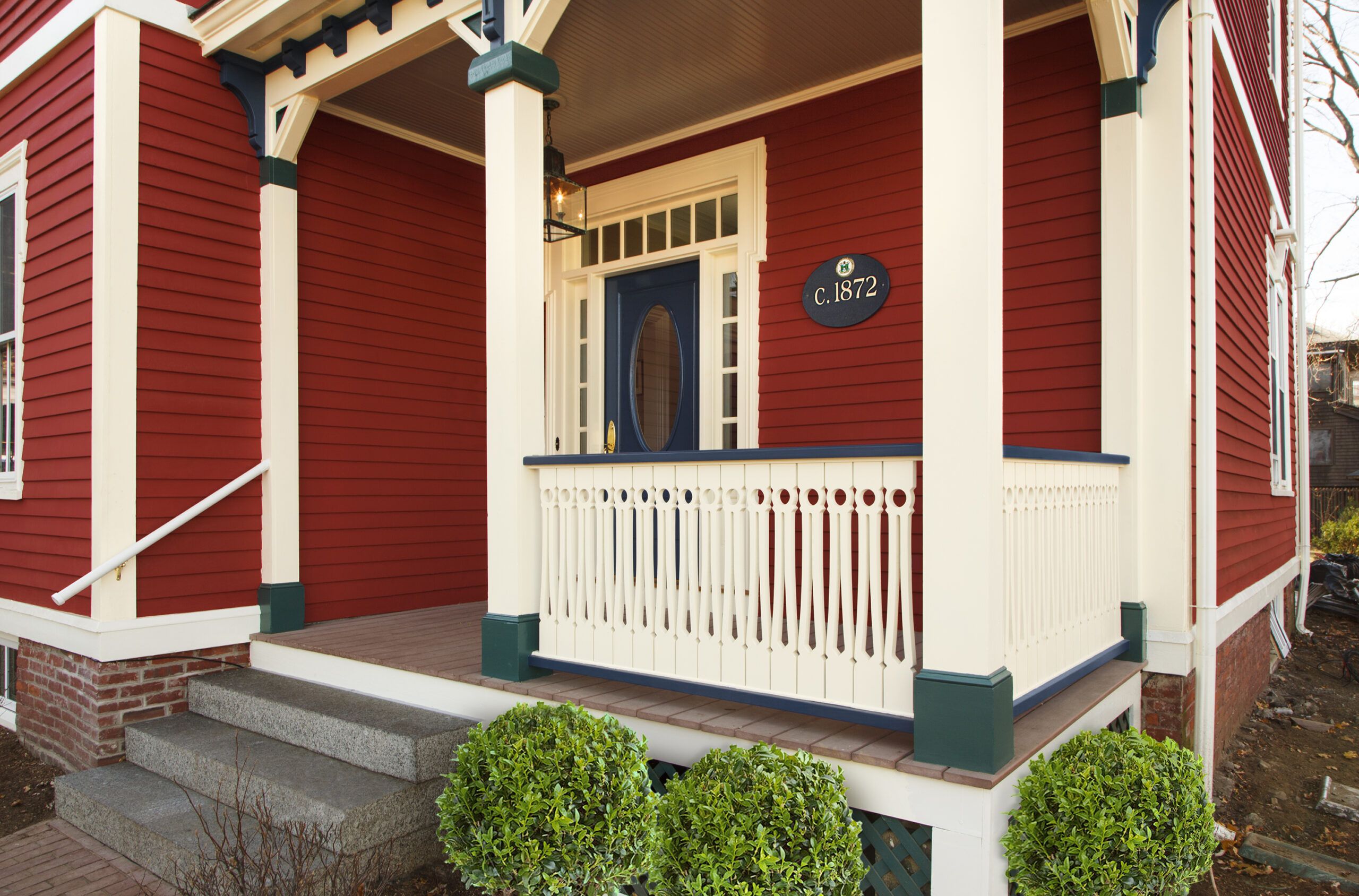We may be compensated if you purchase through links on our website. Our team is committed to delivering honest, objective, and independent reviews on home products and services.
A gingerbread balustrade can transform an ordinary porch into a charming, inviting space that you’ll want to spend time in year-round. This decorative railing, reminiscent of Victorian-era architecture, adds a touch of elegance and personality to any house. In this guide, we’ll walk you through the process of building a gingerbread balustrade, from creating a custom template to installing the finished product.
Overview for How to Build a Gingerbread Balustrade
Before diving into the construction process, you should know the overall timeline and scope of this project. Building a gingerbread balustrade typically takes two days to complete. Here’s how we break down each day:
- Day 1: The first day is dedicated to creating the jig, cutting, and preparing the balusters. This involves designing and crafting a template, constructing the jig, and shaping the individual balusters that will form the decorative elements of your balustrade.
- Day 2: On the second day, you’ll focus on constructing the railing. This includes measuring and cutting the rails, creating the baluster panels, and installing the completed balustrade on your porch.
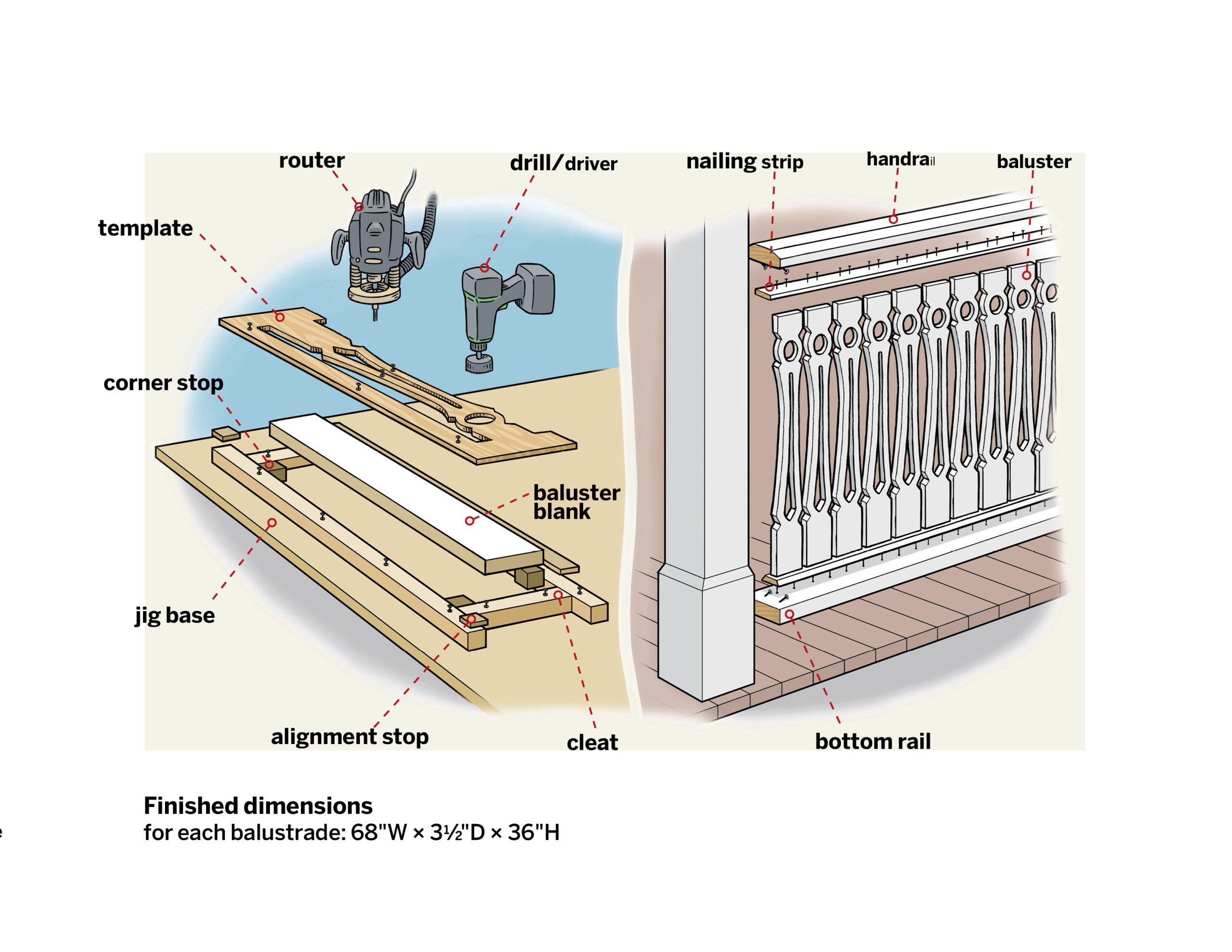
Materials and Tools
Here’s what you’ll need for this project:
- 1/2-inch plywood (for template and jig)
- 1x scrap wood (for measuring and supports)
- Clamps
- Combination countersink bit
- Drill/driver
- Exterior primer
- Hole saw
- Jigsaw
- Miter saw
- Palm sander
- Router (with 3/8- by 2-inch straight bit and 5/8-inch collar)
- Sandpaper (180-grit)
- Screwdriver
- Stainless-steel screws (1 ½-inch)
- Tape measure
- Wood glue
 Jigsaw
Jigsaw Drill/driver
Drill/driver combination countersink drill bit
combination countersink drill bit hole saw bit – 2-inch
hole saw bit – 2-inch Miter saw
Miter saw router
router straight router bit – 3/8- by 2-inch
straight router bit – 3/8- by 2-inch palm sander
palm sander angled sash paintbrush – 2 1/2-inch
angled sash paintbrush – 2 1/2-inch
Follow along as TOH general contractor Tom Silva and master carpenter Norm Abram demonstrate how they used the pattern and a homemade jig to construct this ornate balustrade. Sure, they make it look easy, but they also give you everything you need to know to craft your own custom railing.
Create the Gingerbread Balustrade Template to Make the Jig
The first step in creating your gingerbread balustrade is designing and crafting a template for your balusters. To begin, select a pattern that complements your home’s architectural style. You can draw inspiration from existing designs or create a unique pattern that reflects your taste. Once you’ve decided on a design, transfer the scaled outline onto a sheet of 1/2-inch plywood.
For those who prefer a more precise approach, you can use graph paper to sketch your design before scaling it up to full size. Alternatively, you can use design software to create and print a full-scale template. This ensures all the details are accurate, and it allows you to make adjustments easily before finalizing the design.
After transferring your design, carefully cut along the lines using a jigsaw. If your design includes decorative holes, use a drill fitted with an appropriately sized hole saw to create these openings. These details will add an extra touch of elegance to your balusters.

Construct the Jig
With the template complete, it’s time to construct the jig that will guide your router. Cut a plywood base large enough to accommodate your baluster blanks with extra space around the edges. Next, cut cleats and corner stops from 1/2-inch stock to secure the blanks during routing.
Attach the cleats to the base, leaving enough space for the router bit to start and finish its path. Drill pilot holes and use wood screws to secure the cleats.
For precise alignment, cut 1/2-inch-thick stops and mount them on the cleats to hold the template in the same position for each baluster. Secure these stops with wood glue, ensuring they’re square and level.
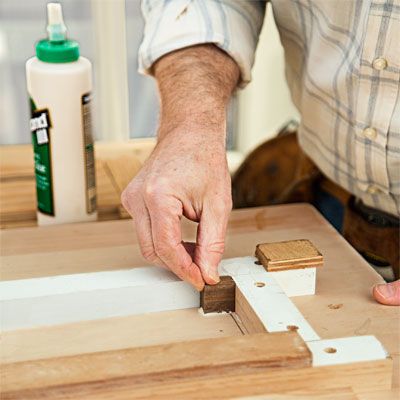
Align the Template to Form the Balusters
Now, you can prepare to shape your first baluster. Begin by cutting your baluster blanks several inches longer than their final height using a miter saw. This extra length allows for any necessary adjustments during the installation process.
Secure your jig to a sturdy work surface to prevent movement during routing. Place the first baluster blank in the jig, positioning it between the cleats and corner stops. Lay your template over the blank, and make sure it fits snugly between the alignment stops you installed earlier.
Using a drill/driver with a combination countersink bit, carefully bore 1/8-inch pilot holes through the template and into the baluster blank and cleats on all sides. These pilot holes will allow you to securely fasten the template to the jig and baluster blank, preventing any movement during the routing process.
Once all pilot holes are drilled, use screws to fasten the template tightly over the baluster blank and cleats. Double-check that everything is secure before proceeding to the routing step.
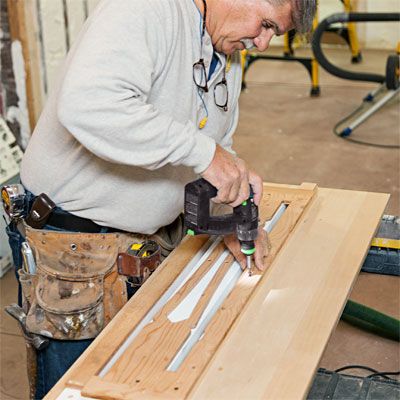
Tip: “Choose a baluster design with gentle curves that a router can easily follow.” — Norm Abram
Rout the Baluster Shape
Now comes the exciting part: shaping your balusters. For this step, you’ll need a router equipped with a 3/8- by 2-inch straight router bit and a 5/8-inch collar. The collar will follow the edge of your template, guiding the bit to create the desired shape.
Begin with the router bit positioned in the space beside the baluster blank. Power up the router and carefully plunge the bit through the jig base. Slowly guide the router counterclockwise around the template, allowing the collar to follow the shaped edge.
As you route, pay close attention to the grain direction of the wood to avoid tear-out. If you encounter areas where the wood grain is difficult to work with, make multiple passes, removing a little material each time for a smoother finish. If your design includes a decorative hole in the center of the baluster, plunge the router bit into the waste area and carefully follow the template’s interior edge.
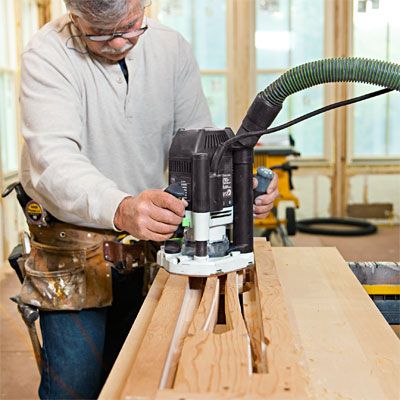
Cut the Decorative Baluster Hole
If your baluster design includes a decorative hole, now is the time to create it. With the baluster still secured in the jig, use a drill/driver fitted with the appropriate size hole saw to cut out the opening. Repeat this process for each plank until you’ve shaped all the balusters needed for your project.
Once all balusters are routed and cut, lay them out on your work surface with the patterns aligned. This will help you visualize the final look of your balustrade and ensure consistency across all pieces. Mark the final length on each baluster, accounting for the height of your porch railing and any space needed beneath the bottom rail. Use a miter saw to trim the balusters to their final size, making sure all cuts are square and even.
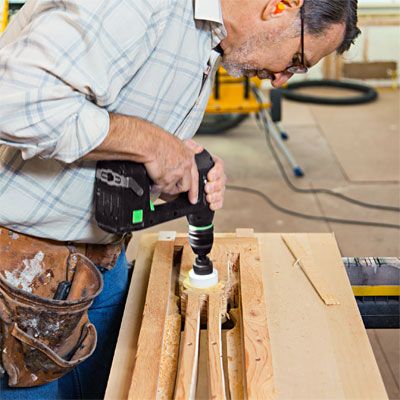
Sand the Balusters
With all your balusters shaped and cut to size, it’s time to smooth out any rough edges and prepare them for finishing. Use a palm sander with 180-grit sandpaper to smooth the faces and outside edges of each baluster. Move the sander in the direction of the wood grain to avoid creating cross-grain scratches.
For the inside edges and any intricate details of your balusters, switch to hand sanding. This allows for greater control and helps you reach areas that might be difficult to access with a power sander. Use the same 180-grit sandpaper wrapped around a sanding block for flat surfaces or folded for curved areas.
Pay special attention to the areas where you made plunge cuts with the router, as these spots may have slightly rougher edges. Sand until all surfaces feel smooth to the touch, being careful not to over-sand and alter the shape of your design.
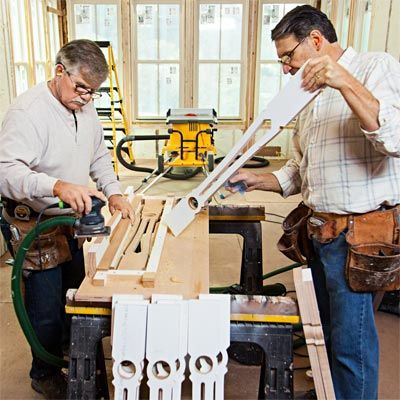
Prime the Baluster Pieces
Set up a well-ventilated area for priming—preferably outdoors or in a garage with open doors. Lay out your balusters on a drop cloth or piece of cardboard to protect your work surface. This will help contain any drips or spills and keep your workspace clean.
Using a high-quality exterior primer, spray or brush an even coat onto all surfaces of each baluster. Be sure to cover all six sides, including the top and bottom edges, as well as any interior cuts or decorative holes. Pay particular attention to end grain areas, which are more susceptible to moisture absorption. These areas may require an extra coat of primer for adequate protection.
Allow the primer to dry according to the manufacturer’s instructions before proceeding to the next step. This typically takes several hours, but may vary depending on temperature and humidity levels.
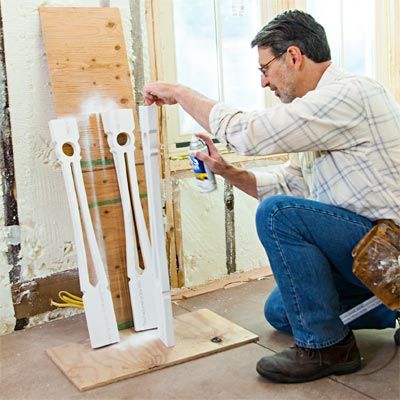
Measure and Cut the Rails for Balustrade
Accurate measurements are crucial for ensuring your balustrade fits perfectly between your porch posts. To begin, cut 1x scraps to the finished height of your railing and stand them up against the porch posts. This will help you visualize the final height of your balustrade.
To measure the span of the handrail, use two long pieces of 1x scrap wood. Overlap these pieces and extend them to the inside faces of the posts, resting them on the standing pieces you just set up. Mark the spot where the two pieces cross. This indicates the length of your handrail.
Keeping the scrap boards aligned at your mark, transfer this measurement to your uncut handrail material. Place the scrap boards flush with one end of the handrail and mark the length at the other end.
Repeat this process for the bottom rail, measuring about 3 inches up from the porch floor. This gap allows for proper drainage and prevents the bottom rail from sitting directly on the porch surface, which could lead to rot over time. Once you have your measurements, use a miter saw or circular saw to cut both the top and bottom rails to size.
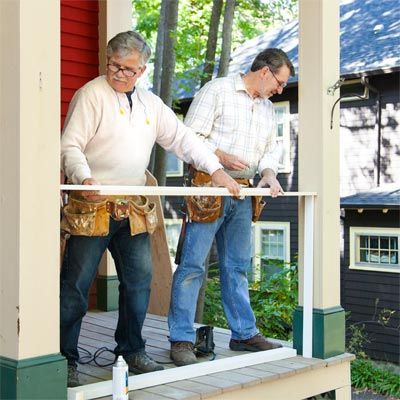
Cut the Nailing Strips for Your Balustrade Panel
Nailing strips play a major role in securing your balusters and creating a sturdy balustrade panel. These strips will be installed along the top and bottom of each run of balusters, sandwiching them in place.
Using the cut rails as a guide, mark the length needed for each nailing strip. It’s important that these strips match the length of your rails exactly for a clean, professional look when the balustrade is assembled. After marking, use a miter saw or circular saw to cross-cut the nailing strips to size.
For the bottom nailing strip, take an extra step to improve water resistance. Use a sanding block to slightly round or bevel the top edges of this strip. This small detail will help shed water away from the balustrade, reducing the risk of water damage and extending the life of your railing.

Make the Baluster Panels
Assembling your balusters into panels makes installation easier and ensures consistent spacing. Begin by laying your nailing strips on the edge of a flat work surface. The distance between these strips should equal the height of your cut balusters.
Next, mark the positions for each baluster along the nailing strips. Use spacers cut to your desired gap width to maintain consistent spacing between balusters. Typically, building codes require that balusters be spaced so that a 4-inch sphere cannot pass between them, so keep this in mind when determining your spacing.
Once you’ve marked all baluster positions, drill 1/8-inch pilot holes through the nailing strips at each mark. These pilot holes will prevent the wood from splitting when you attach the balusters. Position each baluster between the nailing strips, aligning them with your pilot holes. Secure each baluster with two 1 1/2-inch stainless-steel screws at the top and bottom. We recommend stainless steel for its corrosion resistance.
As you assemble the panel, periodically check that everything remains square and level. Make any necessary adjustments before the panel is fully assembled.
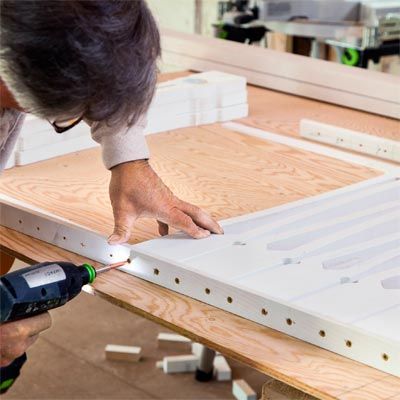
Install the Bottom Rail
Cut 3-inch spacer blocks to prop up the bottom rail between the porch supports. These spacers will create the necessary gap between the rail and the porch floor for proper drainage and ventilation. Position the bottom rail on the spacer blocks and check that it’s level. Drill two 45-degree pilot holes at each end of the rail, angling them into the posts.
Secure the rail to the posts using 2 1/2-inch stainless-steel screws. The angled pilot holes will allow the screws to grip more wood, creating a stronger connection. Double-check the level of the rail after securing it to check that it hasn’t shifted during installation.
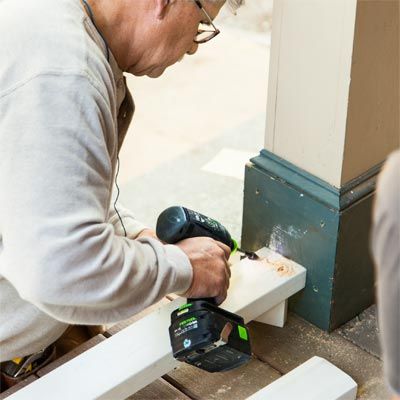
Attach the Baluster Panel
With the bottom rail securely in place, you’re ready to install the baluster panel. This step is best done with a helper. Carefully lift the baluster panel and rest it on the installed bottom rail. Take a moment to center the panel and ensure it’s sitting flush against the posts at both ends.
Once the panel is in position, drill 1/8-inch pilot holes at a slight angle through the bottom nailing strip and into the bottom rail. Space these pilot holes approximately every 12 inches along the length of the rail. Secure the panel to the bottom rail using 1 1/2-inch stainless-steel screws.
Next, install the handrail following the same process. Place it on top of the baluster panel, check for level, and secure it to both the panel and the posts using pilot holes and screws. After the handrail is installed, give the entire balustrade a final check for level and stability.
Our Conclusion
Building a gingerbread balustrade can greatly enhance your home’s charm and character. While the process requires attention to detail, the finished product offers a durable, custom railing that will add beauty and value to your home.
